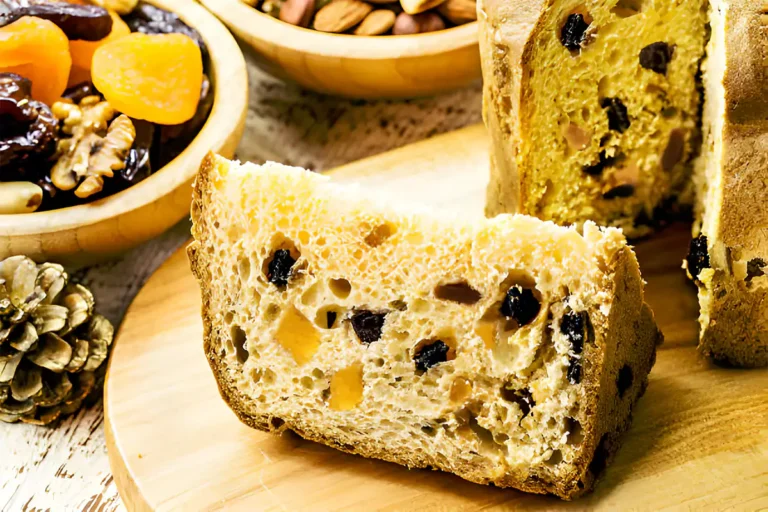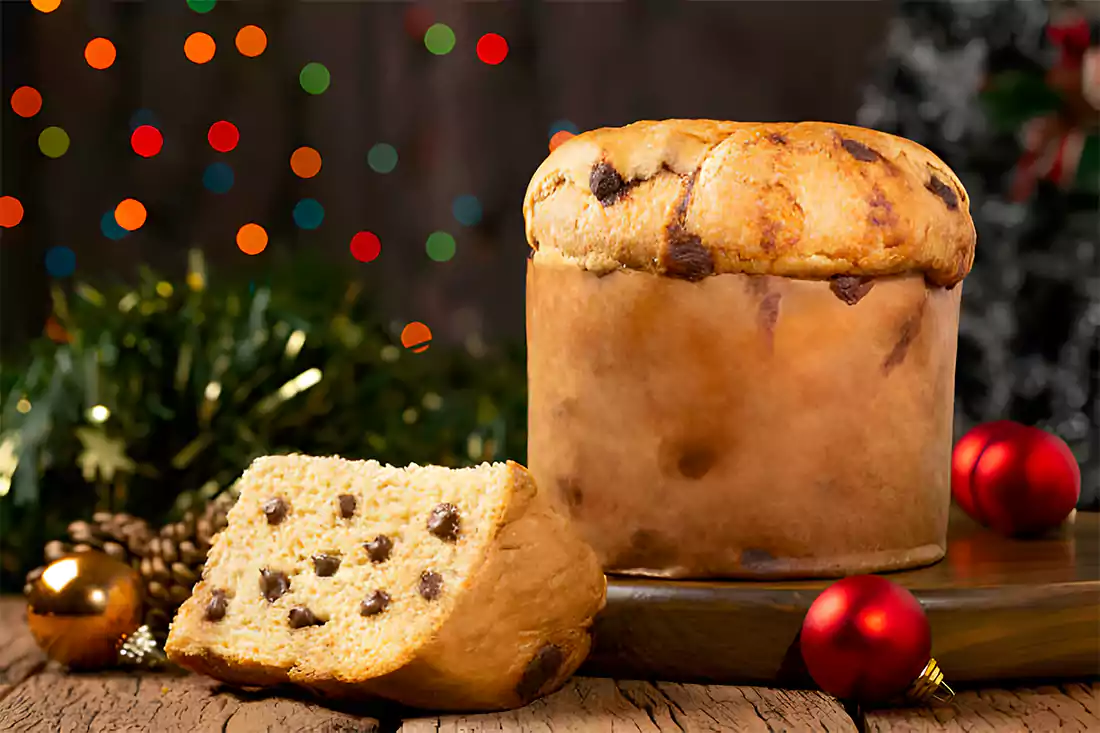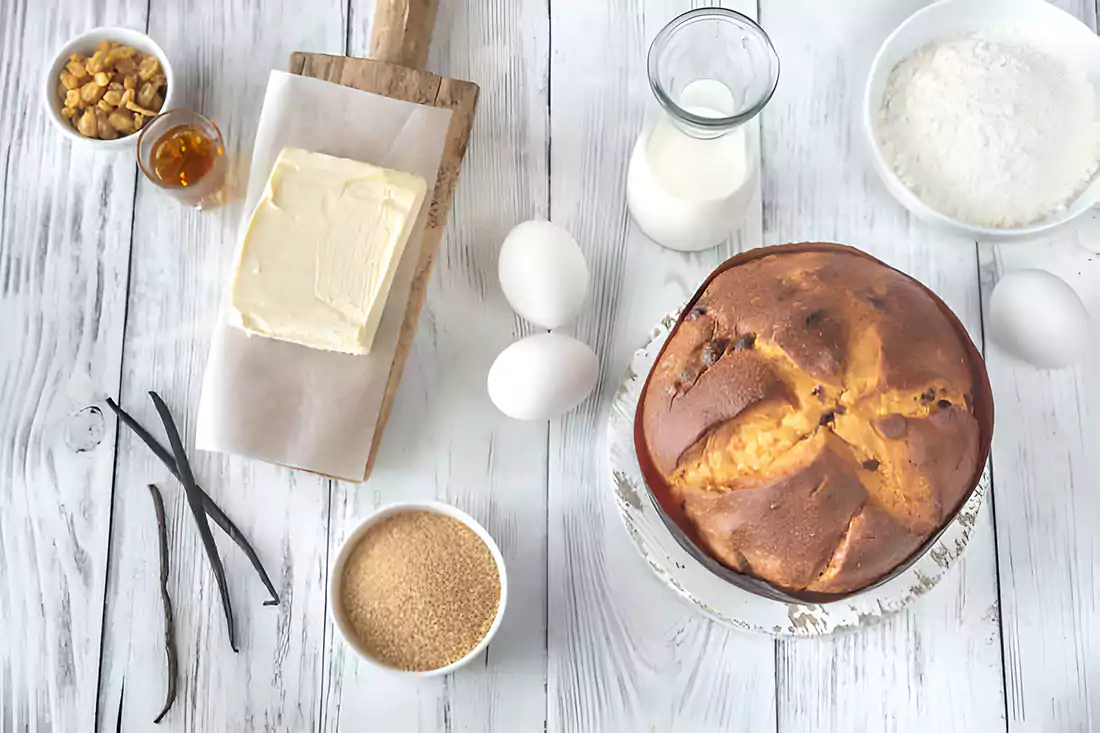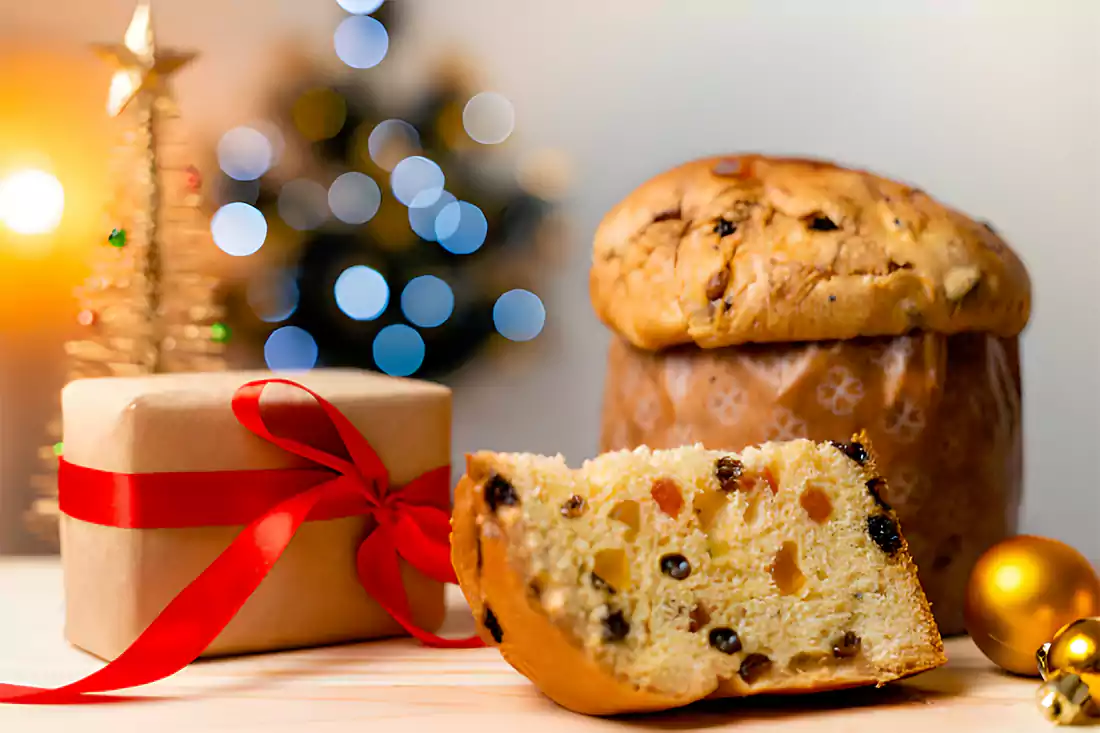Introduction to Panettone
Unveiling the Secret of Panettone: Origin and Popularity
Panettone, an Italian holiday bread, embodies the essence of festive Italian traditions and history. Originating in Milan, this culinary gem has become a global holiday essential.But what’s the secret of Panettone behind its unwavering popularity? Well, it’s a mix of rich history, tantalizing flavors, and a dash of holiday magic.
Ingredients Behind the Secret of Panettone
Every ingredient has a crucial role: flour for texture, candied fruits for bursts of sweetness, eggs and butter for a luxurious crumb, and natural yeast for perfect rising during fermentation.
As we delve into the layers of Panettone, we discover the skill and care behind its creation. It’s more than bread; it’s a symbol of baking artistry and culinary heritage that adapts while remaining authentic. So, as we enjoy each bite, let’s recall its journey from a Milanese delicacy to a worldwide holiday tradition, uncovering the secret of Panettone.
The Secrets Behind Making Panettone
Essential Ingredients: Unlocking the Secret of Panettone
The secret of Panettone lies not just in what you use, but how you use it. Flour, the backbone of any bread, must be strong enough to support the lengthy fermentation and rich dough of Panettone. It’s not just any flour that makes the cut; a high-protein variety is essential for developing the gluten network that gives this festive bread its iconic texture.
Eggs and butter are more than mere ingredients; they’re the luxurious elements that enrich the dough, imparting a richness and tenderness that’s unmistakably Panettone. Each egg yolk is a golden droplet of flavor, while the butter weaves in a velvety texture that melts in your mouth.
Candied fruits and raisins are the jewels in the Panettone crown, offering sweet, chewy contrasts to the soft, airy crumb. These aren’t just any candied fruits; they’re carefully selected and prepared to ensure they complement the dough without overwhelming it.
And then there’s the natural yeast, the silent hero of the Panettone saga. This isn’t your run-of-the-mill baker’s yeast; it’s a carefully cultivated sourdough starter that requires patience and skill to manage. The natural fermentation it drives is crucial for the development of those complex flavors and aromas that make Panettone so irresistible.
Fermentation: The Core Secret of Panettone’s Magic
Fermentation is the enchanting transformation of basic ingredients into a festive masterpiece. It’s a slow, 48-hour dance between yeast and dough, creating a rich, complex flavor and a delightfully airy texture, unlocking the secret of Panettone.
Baking Mastery: The Art Behind Panettone’s Secret
Baking Panettone is an art form, requiring precision and care. The oven isn’t just a tool; it’s a stage where the dough performs, rising and browning to perfection. The right temperature and timing are crucial; too hot, and the crust burns before the inside is done; too slow, and the Panettone doesn’t achieve its characteristic dome.
Baker’s Insights: Revealing the Secret Techniques of Panettone
Every master baker has their secrets, and when it comes to Panettone, these can be game-changers. To make a great Panettone, you need to add a homemade flavor paste, use dough enhancers for a perfect crumb, and master oven calibration and the art of cooling the bread upside down to keep its dome shape.
In the realm of Panettone, generations of secrets and years of practice create a delightful journey of passion, patience, and precision, leading to a delicious final product, unveiling the secret of Panettone.
The Role of Ingredients
Deciphering Panettone’s Ingredients: The Secret Mix
When it comes to crafting the perfect Panettone, every ingredient has a story, a purpose, and a role that goes beyond the mere act of mixing and baking. It’s a symphony where each component plays a crucial part in creating the final masterpiece.
Flour’s Role: The Structural Secret of Panettone
Flour isn’t just the skeleton of Panettone; it’s the very soul that determines its structure and texture. But not just any flour will do. A high-protein flour, often referred to as bread flour, is essential for developing the strong gluten network that Panettone requires. This gluten network is what gives the bread its characteristic airiness and chew, allowing it to rise majestically and maintain its structure.
Eggs and Butter: The Secret to Panettone’s Richness
Eggs and butter elevate Panettone dough, infusing it with richness and depth. Yolks bring color and creaminess, while butter adds a delightful melt-in-your-mouth tenderness. Properly incorporating them is key to enhancing flavor and texture.
Sweetness and Texture: The Secret Touch of Fruits in Panettone
The candied fruits and raisins are more than just add-ins; they’re integral to the Panettone experience, offering bursts of sweetness and texture that contrast beautifully with the soft, tender crumb. But the key is balance. The fruits must be evenly distributed throughout the dough, ensuring that every slice is studded with these sweet jewels, without overwhelming the delicate flavors of the bread itself.
The Secret Fermenting Agent: Natural Yeast in Panettone
In Panettone crafting, ingredients aren’t just mixed; they’re carefully nurtured, each contributing to a masterpiece greater than its parts. This meticulous attention and respect for ingredients elevate a simple bread into a globally celebrated festive delight.
Technical Aspects of Panettone Making
The Secret Behind Panettone’s Technical Perfection
Delving into the technicalities of Panettone baking is akin to exploring a world where science and artistry converge. Each step, from mixing to cooling, is a testament to the baker’s skill and understanding of the craft.
Exploring the Secret Science of Panettone Fermentation
Fermentation is the alchemical process that breathes life into Panettone, transforming a simple dough into a rich, flavorful bread. But this isn’t just about letting the dough rise; it’s about controlling the environment to ensure the yeast thrives, producing the perfect balance of gases and flavors. Temperature, humidity, and time are the trinity that guides this process, each meticulously managed to achieve the desired texture and taste.
The Secret Climate: Temperature and Humidity in Panettone Baking
In Panettone baking, temperature and humidity are vital factors. They impact the outcome significantly. The dough needs warmth and moisture to activate yeast, but excessive heat or humidity can result in overproofing or uneven texture. Skilled bakers carefully control these conditions, often using specialized proofing boxes or monitored baking rooms to ensure Panettone’s success.
Shaping Panettone: The Secret Behind Its Form
Molding and shaping Panettone is an art form in itself, requiring a gentle yet firm touch. The traditional dome shape isn’t just for aesthetics; it’s designed to optimize the bread’s rise and ensure even baking. But achieving this shape is no small feat. It involves a series of folding and tucking techniques, often performed by hand, to create a dough that’s both strong and supple, ready to rise into the iconic Panettone silhouette.
The Final Touch: The Secret of Cooling and Baking Panettone
Mastering Panettone-making involves perfecting baking, cooling, and technique. Baking is the last step, where precise time and temperature turn dough into fragrant golden bread. Cooling is vital, achieved by hanging the bread upside down to keep its dome shape. This craft demands ongoing learning, covering fermentation, dough handling, and precision in baking and cooling. The outcome isn’t merely bread but an artful masterpiece, honoring Italian baking traditions and the baker’s skill.
Modern Variations and Innovations
The world of Panettone is not static; it’s a canvas for creativity and innovation, where traditional techniques meet modern twists to create new, exciting variations of this classic Italian Christmas cake.
Innovative Secrets: Modern Twists on Traditional Panettone
In recent years, the culinary landscape has seen a surge in creative takes on the traditional Panettone. Bakers and chefs alike have been experimenting with a range of ingredients, pushing the boundaries of what Panettone can be. Panettone’s versatility extends beyond the holiday season, thanks to the addition of exotic fruits, gourmet chocolates, artisanal coffees, and fine liquors.
Exploring New Tastes: The Secret Evolution of Panettone Flavors
Modern flavors have spawned a diverse array of Panettone options, such as the tangy sweetness of passion fruit or the decadent fusion of dark chocolate and hazelnut. These variations cater to various tastes, from traditional to adventurous food lovers.
Inclusive Baking: The Secret to Panettone for Everyone
Firstly, modern Panettone innovation focuses on inclusivity, offering gluten-free and vegan options that replicate the traditional texture and flavor. Additionally, this demonstrates how tradition and innovation can coexist, keeping Panettone a beloved holiday tradition. Moreover, the evolution of Panettone celebrates culinary creativity, ensuring its enduring legacy.
Frequently Asked Questions
In the world of Panettone, curiosity abounds. Additionally, from its intricate making process to its rich history, there are always questions waiting to be answered. First and foremost, let’s dive into some of the most common queries that enthusiasts and novices alike ponder.
What makes panettone different from other holiday breads?
Panettone, with its unique dome shape, airy texture, and sweet candied fruits, stands out among holiday breads, offering a delightful contrast to denser, spicier options of the season.
How long does it take to make traditional panettone?
Can panettone be made without candied fruits?
Absolutely! While candied fruits are a hallmark of traditional Panettone, the beauty of this bread lies in its versatility. For those seeking a less sweet, fruit-free option, many variations skip candied fruits, emphasizing the dough’s rich, buttery flavor.



